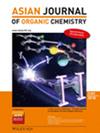过氧化氢在Sn‐,Ti‐,Zr‐和Hf‐β沸石上的Baeyer-Villiger和环氧化反应:DFT研究
IF 2.8
4区 化学
Q1 CHEMISTRY, ORGANIC
引用次数: 0
摘要
采用M06‐L密度泛函理论研究了二氢香豆酮与过氧化氢在沸石催化剂上的Baeyer-Villiger反应和环氧化反应。在Sn‐,Ti‐,Zr‐和Hf‐β沸石的38T量子团簇上的Baeyer-Villiger反应被认为是两步反应,其表观活化能分别为5.3,18.1,−1.3和−0.9 kcal/mol,能量跨度分别为33.6,40.1,31.1和34.8 kcal/mol。Sn‐、Ti‐、Zr‐和Hf‐沸石上竞争性环氧化反应的活化能分别为11.2、16.2、16.4和15.0 kcal/mol。Sn - β沸石选择性地提供内酯产物,因为它形成了热力学上有利的吸附和产物配合物,并且bayer - villiger反应的表观活化能较低。Zr - β和Hf - β沸石被认为是Baeyer-Villiger氧化的选择性催化剂。在没有沸石的情况下,对间氯过苯甲酸的反应也进行了研究。由于环氧化反应的活化能较低(分别为16.6 kcal/mol和39.4 kcal/mol),因此环氧化反应优于Baeyer-Villiger反应。用不同的路易斯酸沸石催化剂研究了其催化活性和化学选择性。本文章由计算机程序翻译,如有差异,请以英文原文为准。
Baeyer–Villiger and Epoxidation Reactions of Dihydrocarvone using Hydrogen Peroxide over Sn‐, Ti‐, Zr‐, and Hf‐Beta Zeolites: A DFT Study
The Baeyer–Villiger and epoxidation reactions of dihydrocarvone with hydrogen peroxide over zeolite catalysts is investigated using the M06‐L density functional theory. The Baeyer–Villiger reaction over 38T quantum clusters of Sn‐, Ti‐, Zr‐, and Hf‐beta zeolites is thought to proceed via a two‐step mechanism with apparent activation energies of 5.3, 18.1, −1.3, and −0.9 kcal/mol and energy spans of 33.6, 40.1, 31.1, and 34.8 kcal/mol, respectively. The calculated activation energies of competitive epoxidation reactions over Sn‐, Ti‐, Zr‐, and Hf‐beta zeolites are 11.2, 16.2, 16.4, and 15.0 kcal/mol, respectively. The Sn‐beta zeolite selectively afforded the lactone product owing to the formation of thermodynamically favored adsorption and product complexes and the lower apparent activation energy of the Baeyer–Villiger reaction. Zr‐beta and Hf‐beta zeolites are thought to be selective catalysts toward Baeyer–Villiger oxidation. Reactions without zeolites are also studied over m‐chloroperbenzoic acid. The epoxidation is favored over the Baeyer–Villiger reaction owing to its lower activation energy (16.6 kcal/mol vs. 39.4 kcal/mol). The catalytic activity and chemoselectivity are studied using various Lewis acid zeolite catalysts.
求助全文
通过发布文献求助,成功后即可免费获取论文全文。
去求助
来源期刊

Asian Journal of Organic Chemistry
CHEMISTRY, ORGANIC-
CiteScore
4.70
自引率
3.70%
发文量
372
期刊介绍:
Organic chemistry is the fundamental science that stands at the heart of chemistry, biology, and materials science. Research in these areas is vigorous and truly international, with three major regions making almost equal contributions: America, Europe and Asia. Asia now has its own top international organic chemistry journal—the Asian Journal of Organic Chemistry (AsianJOC)
The AsianJOC is designed to be a top-ranked international research journal and publishes primary research as well as critical secondary information from authors across the world. The journal covers organic chemistry in its entirety. Authors and readers come from academia, the chemical industry, and government laboratories.
 求助内容:
求助内容: 应助结果提醒方式:
应助结果提醒方式:


